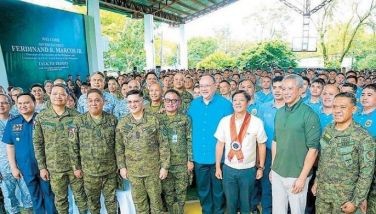How representative is Congress?
March 22, 2004 | 12:00am
They are also older and better educated. As the results of a two-year PCIJ study of legislatures since 1898 show, members of the post-Marcos Congress tend to stay in office longer than their predecessors.
Moreover, most lawmakers come from political families, meaning that they have relatives who are currently holding or once held elective posts. In the House of Representatives, two of every three are members of political clans. The vast majority of these are second- and third-generation politicians with parents and grandparents who had been elected to public office.
In less than two months, Filipinos will be voting for a new set of legislators. Senatorial candidates have been campaigning since February. This week, they will be joined by those vying for seats in the House. If the results of previous elections are a guide, then the likelihood is that most of the legislators who will assume their seats in July would be so unlike the people who voted them to power.
The typical representative or senator cannot be more unlike the typical Filipino. The legislator is likely to be male, middle aged, and college educated, most likely with a degree in law. He has previously held a local government post and there is one chance in two that he is related to a former member of Congress.
He is also into business and has multiple income sources. He has property for rent, earns salary from a profession, and has investments in company shares. He is well off, with a net worth (most likely understated in his statement of assets) in millions of pesos. And the likelihood is that the longer he stays in Congress, the richer he becomes.
In 1962, only 27 percent of representatives were classified as upper class. In 1992, it was 44 percent. Over time, the assets of legislators have grown. In 1992, the average net worth of congressmen was P8 million. By 2001, it was P22 million. In the Senate, the average net worth increased from P33 million in 1998 to P59 million in 2001. A quarter of all senators today have a net worth of above P100 million.
The typical Filipino, meanwhile, is likely to be below 35, with a few years of high-school education, and an annual income of about P150,000 in 2000. The demographic profiles couldn’t be more unmatched.
Five congresses - the Eighth to the 12th - have been constituted since the fall of Ferdinand Marcos in 1986. The legislators elected to these bodies have hardly been representative of those they represent. In that sense, they have not been different from the past, when members of Congress were drawn from a narrow elite in terms of property, education (since 1898, they have been trained mainly in law) and social standing.
There have been changes, though. There are now many more women in Congress than there have been in the past. In the current House, there are 40 women, about 18 percent of the body, compared to only one percent in 1946, six percent in 1965, and 11 percent in 1992.
Today’s legislators are also better educated than their predecessors, with 27 percent of all representatives boasting of postgraduate degrees, compared to only 18 percent in 1965.
The sources of their wealth are more diverse, indicating that many more business interests are represented in Congress, which can no longer be described as "landlord-dominated" legislature. The caciques of old have been replaced by real-estate developers, bankers, stockbrokers, and assorted professionals and businesspeople.
The changes reflect the changes in the Philippine economy, with the decline of agriculture and extractive industries (logging, mining) and the increasing importance of manufacturing, trade, and services. The changes have been obvious since the 1960s, when new men from business and the professions were elected to the legislature.
The rise of these new legislators mirrored the increasing political assertiveness of new sections of the business elite and the upper professional class that emerged in the 1950s and 60s. That period saw the birth of a manufacturing sector that produced previously imported goods for the local market. While many of those who became part of the manufacturing capitalists were large landowners, there were also those from the professional middle class and local traders who joined the ranks of the new rich and then sought seats in Congress.
Philippine legislatures have been hospitable to the entry of the newly affluent. Their ranks have been open to the constant infusion of new blood. The post-Marcos Congress is even more diverse in composition than its predecessors. It includes, aside from the old landowning families that have been in legislatures for 100 years, also new entrepreneurs, especially those in construction, real estate, and services that emerged among the fastest-growing economic sectors in the late 1980s and 1990s; middle-class professionals, especially lawyers from leading law firms; and leaders of nongovernment organizations.
The legislature also has local officials or government bureaucrats able to build a base in their districts even if they are not backed by old wealth. In addition, the halls of Congress have recently accommodated celebrities from the movies, the mass media and sports.
Such mobility, however, is still limited to a narrow range of Philippine society. For sure, the more occupationally diverse membership from the more modern sectors of business, the mass media, and civil society means a wider range of perspectives and interests than at any time in the past. The trend toward increasing diversification that was noted in the 1960s continues today.
Moreover, the entry of party-list representatives in the 11th and 12th Congresses enlarged that range, as it gave representatives of marginalized social sectors seats in the legislature. Despite this, however, Congress remains a fortress of privilege, its gates open to the new and aspiring rich, but closed — except for some narrow openings - to the poor and powerless.
The route to Congress, for the most part, is still via local government posts. Although recently, some have taken a shortcut, either through the media or the movies, or inherited their posts directly from a relative facing the three-term limit, the usual route is still for prospective legislators, even those who come from political families, to vie for "lesser" elective posts.
This trend was evident from the start. Political office in the Philippines has always been hierarchical: Aspiring politicians went up the political ladder from local to national office, from the House to the Senate, and from the Senate to the presidency. The upheavals caused by martial law disrupted this flow. The formula no longer works for those aspiring for the Senate and the presidency. But the path from local office to the House remains well trodden, although it has been fast-tracked for many because of the three-term limit.
In the 12th House that assumed office in 2001, 138 representatives — 61 percent - had been in public office prior to their first election to a post-Marcos House. Fewer representatives now come from the executive branch. Most of them - 49 percent of all representatives or 81 percent of those who had held public posts - had been elected to local office.
This shows the importance of a local political base in winning a House seat. Political families have the edge, because they can mobilize local patronage and political networks for their electoral forays. The same is not true of the Senate, however, because name recognition is more important in that chamber, allowing celebrities from the media and the movies to win hands down in national races even if they don’t have a base in their districts. There are fewer celebrities in the House, although that is changing.
The passing on of a legislative seat from one generation to another provides evidence of the caste-like structure of the legislative elite. Four in every 10 representatives in all the post-Marcos Congresses had relatives in previous legislatures. A third had parents who were in public office.
These are unusually high percentages and are an important index of the extent of real "democratization" that has taken place. But they still show, though, that Congress is not closed to those who do not come from powerful families. The flipside of the equation - six in every 10 representatives are not related to former legislators and seven out of 10 do not have parents who were in public office - should not be overlooked.
Once in Congress, however, legislators tend to stay there. The pattern since 1946 is for the number of first-termers in the House to decrease as time goes by, as congressmen hang on to their seats, using the perks and the powers available to their office to perpetuate themselves in power. Conversely, the number of those with multiple terms increases with time.
The trend is evident in the post-Marcos House as well, where the turnover rates would have been faster, as shown in the steep decline in the number of first-termers from the Eighth to the 10th House. By the 10th Congress, only 17 percent of representatives were on their first term, compared to 72 percent in the Eighth House.
This rapid decline was stemmed by the constitutional prohibition on more than three consecutive terms. The impact of the ban is evident in the sudden rise to 60 percent of the number of first-termers in the 11th House, only to decline again when a new House came to power in 2001.
Taken altogether, however, the turnover rate in the post-Marcos Congress is slower than that in pre-martial law years, despite term limits. From 1946 to 1961, an average of 51 percent of all members of Congress were new. The average for all the five post-EDSA congresses is only 46 percent. It would seem that there is less mobility in the post-EDSA legislature.
Families survive wars, dictatorships, and uprisings. The most enduring political families are the best evidence of this: The Aquinos and Cojuangcos of Tarlac, the Osmeñas of Cebu, the Romualdezes of Leyte, and the Marcoses of Ilocos Norte, among other clans, have been in Philippine legislatures for four generations. Some families eventually go into decline after successive electoral defeats or the death of a powerful patriarch, but others, stronger and more resilient, hang on and flourish.
Data gathered for the PCIJ study show the persistence of political families since the fall of Marcos. The reality is still that politicians are elected largely by mobilizing their kinship networks and family assets (e.g. money, name recall, connections). Once in office, they pave the way for other relatives to be either appointed to the bureaucracy or elected to government posts. Within a few years, a newly elected legislator will likely have kin in local office, various government agencies, and state-owned corporations. Before long, the next generation takes over.
Two-thirds of the legislators in the post-Marcos Congress are members of political families. Of these, 70 percent are second and third-generation politicians. Nearly all of them also have multiple relatives in public office.
In the Eighth Congress, the first post-Marcos legislature, 61 percent or 122 of 198 representatives were from political clans. The proportion has remained pretty much the same since then, despite the entry of party-list representatives in the 11th and 12th House. In the 12th Congress, which was elected in 2001, 61 percent or 140 of 228 representatives came from political clans. In the 11th House, it was 62 percent. If the percentages are computed without the party-list representatives, however, the numbers increase to 65 percent for the 11th House and 66 percent for the 12th.
The figures indicate that term limits set by the 1987 Constitution, which banned representatives from seeking more than three consecutive terms, did not make a dent on clan power. Representatives who were elected in the Eighth House, for example, could sit only up to the 10th Congress. And yet, the number of political family members in the 111th House is not much different from the ones before it. In many cases, the clans simply fielded other family members to replace those who faced term limits. In other cases, rival clans merely took the place of the incumbent ones.
BrandSpace Articles
<
>
- Latest
- Trending
Trending
Latest
Trending
Latest
Recommended































